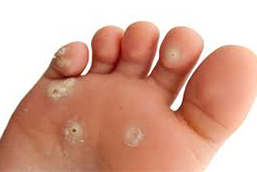Warts
Warts are non-cancerous skin growths caused by a viral infection in the top layer of the skin. Viruses that cause warts are called human papillomavirus (HPV). Warts are usually skin-colored and feel rough to the touch, but they can be dark, flat and smooth. The appearance of a wart depends on where it is growing.

Different kinds of warts
There are several different kinds of warts including:
- Common warts: Usually grow on the fingers, around the nails and on the backs of the hands. They are more common where skin has been broken, for example where fingernails are bitten or hangnails picked. These are often called "seed" warts because the blood vessels to the wart produce black dots that look like seeds.
- Foot (Plantar) warts: Are usually on the soles (plantar area) of the feet and are called plantar warts. When plantar warts grow in clusters they are known as mosaic warts. Most plantar warts do not stick up above the surface like common warts because the pressure of walking flattens them and pushes them back into the skin. Like common warts, these warts may have black dots. Plantar warts have a bad reputation because they can be painful, feeling like a stone in the shoe.
- Flat warts: Are smaller and smoother than other warts. They tend to grow in large numbers - 20 to 100 at any one time. They can occur anywhere, but in children they are most common on the face. In adults they are often found in the beard area in men and on the legs in women. Irritation from shaving probably accounts for this.
At High-risk
Warts are passed from person to person, sometimes indirectly. The time from the first contact to the time the warts have grown large enough to be seen is often several months. The risk of catching hand, foot, or flat warts from another person is small.
Treatment
Dermatologists are trained to use a variety of treatments, depending on the age of the patient and the type of wart.
1. Salicylic Acid Lotion
In young children can be treated at home by their parents on a daily basis by applying salicylic acid gel, solution or plaster. There is usually little discomfort but it can take many weeks of treatment to obtain favorable results. Treatment should be stopped at least temporarily if the wart becomes sore.
2. Cryotherapy
For adults and older children cryotherapy (freezing) is generally preferred. This treatment is not too painful and rarely results in scarring. However, repeat treatments at one to three week intervals are often necessary.
3. Radiosurgery & Electrocautery
Radiosurgery & Electrosurgery (burning) is another good alternative treatment. Laser treatment can also be used for resistant warts that have not responded to other therapies.
4. Laser
Pulsed dye laser CO2 laser
5. Other treatments
Another treatment is to inject each wart with an anti-cancer drug called bleomycin. The injections may be painful and can have other side effects.
6. Warts may also be injected with interferon, a treatment to boost the immune reaction and cause rejection of the wart.
7. Immunotherapy
Immunotherapy, which attempts to use the body’s own rejection system is another method of treatment. Several methods of immunotherapy are being used. With one method the patient is made allergic to a certain chemical which is then painted on the wart. A mild allergic reaction occurs around the treated warts, and may result in the disappearance of the warts.
8. General measures
Avoid nail biting , deep cutting of nails .


